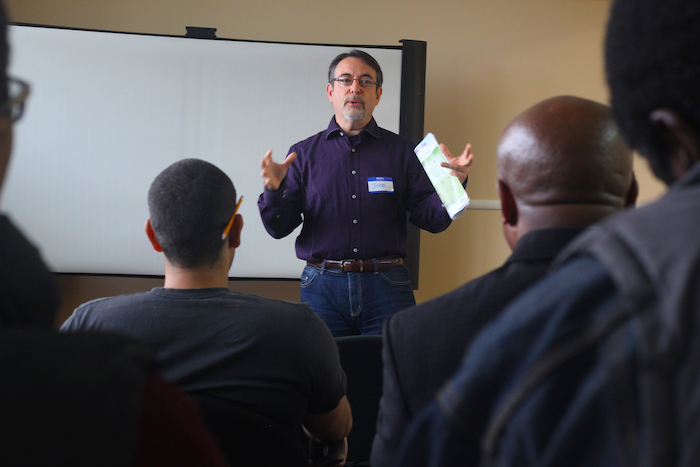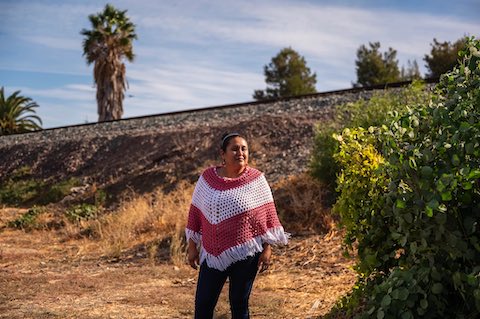
09 Apr Tackling Poverty in the Bay Area
News Report, Ann Bassette
Concerned residents, researchers and public officials came together at the Regional Poverty and Policy Community workshop in Richmond last month to discuss causes and solutions of poverty in the Bay Area.
Participants at the event — held at Solar Richmond, a nonprofit that provides free training in solar and green jobs for low-income and under-employed residents — explored the definition of poverty, looked at ways to decrease it and discussed the potential benefits and drawbacks of policies like rent control, increased minimum wage and education systems.
Held in collaboration with Rise Together, a group of organizations and leaders from every county in the region who work together to deal with poverty, the event drew out roughly 40 people. Before breaking out into discussion sessions, participants heard presentations from Haas Institute for a Fair and Inclusive Society and the Insight Center for Community Economic Development, a national organization committed to building financial wellbeing and opportunity in vulnerable communities.
“This is part of a Bay Area wide effort to cut poverty in half by 2020,” said John Gioia, Contra Costa County supervisor and co- chair of the Rise Together group.
“This larger effort is meant to help provide more capacity to change policies, to help the people and organizations that are doing poverty reduction work today,” he added.
Riana Shaw-Robinson, a Richmond native and director of Rise Together, said the issue went beyond getting people out of poverty.
“How do they really get to experience prosperity?” she asked participants. “What does it really take to live adequately in the Bay Area, to be able to take care of your family, to be able to afford childcare and healthcare and food and housing?”
Gabriella Sandoval, director of research and chief economic security officer at the Insight Center, used her presentation time, in part, to tackle that question and describe the organization’s findings on cost of living.
“In Contra Costa County 28.7 percent of households live below the self sufficiency standard,” said Sandoval.
She said that the “Economic Self-Sufficiency Standard” measures how much income is needed for a family, living in a particular county, to adequately meet its basic needs — a measure that she said provides a more realistic sense of necessary earning than federal poverty levels.
As an example, Sandoval said for a family of three (one adult, one preschooler and one teenage child), economic security would require an annual household income of $58,650. But, if the adult is working a full time minimum wage job at $9 an hour, he or she is only making $18,720 annually. That’s just slightly under the federal poverty line of $19,790, but significantly less than the economic security level.
In the breakout group, following the presentation, some expressed concern that disadvantage begins early in Richmond, starting in elementary school. Residents said they were upset with the current education system and the lack of basic tools such as paper, pencils and books.
Kenyon Roy, a student with Solar Richmond recalled being handed photocopied papers instead of textbooks while attending Kennedy High School in the 1990s. (Research by the Insight Center found that an increase in high school graduation rates could create an average increase of $25,923 in household wages.)
Participants agreed uniformly that community members are not as connected as they should be, that many people are not taking advantage of local programs which can significantly enhance education and ability to earn more. For example, according to Roy, only five people are currently taking advantage of the free education Solar Richmond provides.
In addition to the education and opportunity gap, participants discussed concerns over they Bay Area’s ever-growing population. According to recently released numbers from the U.S. Census Bureau, the population in the Bay Area’s nine counties increased by about 100,000 people between July 2013, and July 2014 — nearly double the percentage growth rate the region experienced between 2000 and 2013.
People also expressed concern over rising rents as a result of the growth and discussed how policy changes like rent control and renter safety might help.
Edith Pastrano of Alliance of Californians for Community Empowerment, said the rent for some tenants the group works with was increased $50 per month last year, and now $200 per month this year, which she said creates a devastating impact.
Another popular topic covered, was an increased regional minimum wage. People said they felt that if more people could earn a livable wage, there would be less people relying on profit from underground hustles dealing with drugs, guns, prostitution, and theft.
“We can’t just focus on poverty in Richmond because people move, “ said Gioia in a phone interview. “That’s why the focus is on working a region. Changing policies from a regional level is what’s most important,” he said. “And the Bay Area economy is competing against economies across the world.”






2 Comments